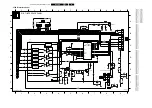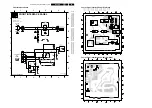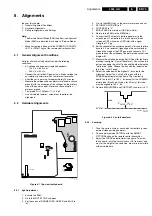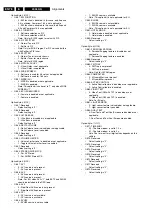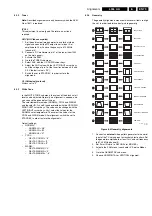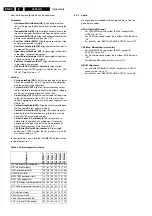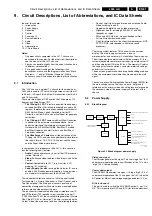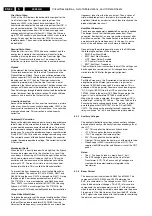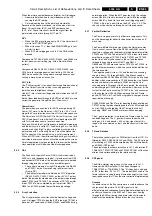
Circuit Descriptions, List of Abbreviations, and IC Data Sheets
9.
First Part of Scan
Pin 62 of the UOC delivers the horizontal drive signal for the
Line Output stage. This signal is a square pulse of line
frequency. L5402 is the flyback drive transformer. This
transformer de-couples the line output stage from the UOC. It
has a direct polarization. The flyback drive circuit works with
the start-up supply taken from +6V of the Aux supply (and
subsequently taking from 9V). When the H-drive is
high, TS7404 conducts, and transformer L5402 starts to store
energy. The base of the line transistor TS7405 is low and
therefore blocks. The current in the deflection coil returns from
diode D6404.
Second Part of Scan
When the H-drive is low, TS7404 does not conduct, and the
energy that is stored in the transformer will transfer to the
secondary, making the base of the Line Transistor high. Then
the Line Transistor starts to conduct. The current in the
deflection coil returns from the transistor in another direction.
Flyback
At the moment the H-drive becomes high, the base of the Line
Transistor becomes low. Both the Line Transistor and the
Flyback Diode will block. There is an oscillation between the
flyback capacitor C2412 and the deflection coil. Because of the
inductance of the LOT, the Line Transistor cannot stop
conducting immediately. After the Line Transistor is out of
conduction, the flyback pulse is created. The flyback capacitor
charges until the current in the deflection coil reduce to zero.
Then it discharges through the deflection coil and the deflection
current increases from the other direction. The flyback diode
conducts and is back to the first part of the scan.
Linearity Correction
Because the deflection coil has a certain resistance, a picture
without any linearity issues cannot be expected. L5401 is the
linearity coil to compensate for this resistance. It is a coil with a
pre-magnetized core. This correction is called linearity
correction.
Horizontal S-Correction
Because the electronic beam needs to travel a longer distance
to both sides of the screen than the center, the middle of the
screen would become narrower than both sides. To prevent
this, a parabolic voltage is applied across the deflection coil
during scan. To create this parabolic voltage, a capacitor called
S-cap (C2417/C2418) is used as a voltage source during scan.
The sawtooth current of the deflection through this capacitor
creates the required parabolic voltage. This correction is called
S-Correction.
Mannheim-Circuit
When the EHT is heavily loaded with a bright line, the flyback
time can be increased a bit in this situation. As a result, the
scan delays a bit causing a DC-shift to the right in the next line,
which would create a small spike on the S-cap. This spike
oscillates with the inductance of the deflection coil and the
primary of LOT. The result is visible in vertical lines under
horizontal white line. This is called the Mannheim-effect.
To prevent this from happening, a circuit called Mannheim-
circuit is added. This consists of C2415, R3404, R3417 and
D6406. During the scan, C2415 is charged via R3417. During
the flyback, the S-correction parabola across the S-Cap
C2417/C2418 is in its most negative, and D6406 conducts.
Thus, C2415 is switched in parallel to C2417/C2418 during
flyback. As C2415 is much larger than C2417/C2418, the
voltage across C2415 reduces the Mannheim-effect oscillation.
Class D East-West Driver
To reduce the power loss of the normal used linear East-West
amplifier, a class-D East-West circuit is used. To achieve this,
the East-West parabola waveform EW_DRIVE from the
Hercules (frame frequency) is sampled with a saw tooth (line
frequency) taken from the line aux output. Then a series of
width-modulated pulses is formed via two inverted phase
amplifiers, filtered by an inductor, which then directly drive the
diode modulated line circuit.
East-West Correction
To achieve a good geometry, dynamic S-correction is needed.
The design is such that the tube/yoke needs East-West
correction. Besides that, an inner pincushion is present after
East-West correction. The line deflection is modulated with a
parabolic voltage (frame frequency). In this way it is not so
much at top and bottom, and much more in the middle.
Upon entering the picture geometry menu in the SAM mode,
the following corrections will be displayed.
•
EWW: East West Width.
•
EWP: East West Parabola.
•
UCP: Upper Corner Parabola.
•
LCP: Lower Corner Parabola.
•
EWT: East West Trapezium.
The East-West drive circuit realizes them all. The settings can
be changed by a remote control. All changed data will be
stored into the NVM after the geometry alignment.
Panorama
For Wide Screen sets, the S-correction of the picture has to
adapt between the different picture modes. In particular,
between 16:9 Wide Screen and 4:3 picture modes. This is
achieved with the (separate) Panorama circuit (see diagram
“G”). A signal (I2SDI1) from the UOC controls the state of
TS7463. When in the normal 16:9 Wide Screen mode, the
signal is “low” and therefore TS7463 is switched “off”.
When the 4:3 mode is selected, this signal from the UOC is
pulled “high”, switching TS7463 “on”. The relay 1463 on the
Panorama panel is subsequently turned “on” and, in effect,
paralleling capacitor C2475/C2474 to the S-Cap C2469/
C2470. This changes the overall effective S-correction. The
relay is switched “on” in 4:3 and Superwide picture modes.
9.3.3
Auxiliary Voltages
The horizontal deflection provides various auxiliary voltages
derived either directly or indirectly from the secondary pins of
the LOT:
•
+9V: This supplies the Hercules’s flyback driver.
•
+11V: This supplies the frame amplifier.
•
-12V: This supplies the frame amplifier.
•
50V: This supplies the frame amplifier.
•
Filament: This supplies the heater pins of the picture tube.
•
VideoSupply (+200V from primary side of LOT): This
supplies the RGB amplifier and Scavem circuit at the CRT
panel.
Notes:
•
The V_T voltage (to tuner) is drawn from V_batt.
•
The EHT voltage is generated by the Line Output
Transformer (LOT). The Focus and Vg2 voltages are
created with two potentiometers integrated in the
transformer.
9.3.4
Beam Current
The beam current is adjusted with R3451 and R3452. The
components R3473, R3453 and C2451 determine the
EHT_info characteristic. The voltage across C2412 varies
when the beam current changes. This EHT_info is used to
compensate the picture geometry via pin 97 of the Hercules
when the picture changes rapidly, and compensate the phase
2 loop via pin 113 of the Hercules. Also from the EHT_info line,
a BCL signal is derived and sent to the Hercules for controlling
the picture’s contrast and brightness.
Summary of Contents for L04LAA
Page 36: ...Service Modes Error Codes and Fault Finding EN 36 L04L AA 5 E_06532_012 eps 130204 ...
Page 58: ...58 L04L AA 7 Circuit Diagrams and PWB Layouts Layout Mono Carrier Part 1 Bottom Side Part 1 ...
Page 93: ...Spare Parts List EN 93 L04L AA 10 10 Spare Parts List Not applicable ...
Page 94: ...Revision List EN 94 L04L AA 11 11 Revision List First release ...

